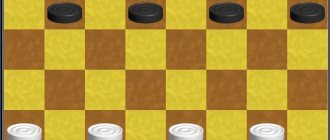Diagnosis of attention development in preschoolers and primary schoolchildren. Part 2
Start
By the age of six, not only does the number of objects that a child is able to simultaneously perceive increase, but the range of objects that attract children’s attention also changes. If at three or four years old the child’s attention was attracted by bright, unusual objects, then at the age of six - by outwardly unremarkable objects. A child’s interest can increasingly be aroused by a riddle or a question. And in those objects that the child liked before, he begins to notice something different. He is increasingly interested in the person himself, his activities, and not so much in outwardly bright, unusual objects. The child notices details in a person’s appearance, behavior, and clothing.
Sustainability of attention shows how long a child can maintain a sufficient level of mental concentration on an object or activity being performed.
If younger preschoolers can play the same game for 30-50 minutes, then by the age of five or six years the duration of the game increases to two hours. This is explained by the fact that the play of six-year-olds reflects more complex actions and relationships between people, and interest in it is maintained by the constant introduction of new situations.
The stability of attention increases when looking at pictures, listening to stories and fairy tales. As the famous child psychologist V.S. Mukhina points out, the duration of looking at a picture approximately doubles by the end of preschool age; A six-year-old child is more aware of a picture than a younger preschooler and identifies more interesting aspects and details in it.
In a study by T.V. Petukhova, preschoolers were given an unattractive task: they had to put scraps of colored paper into boxes of different colors. The duration of such activity and the duration of distraction from it were noted. It turned out that children five and a half to six and a half years old can do things that are of little interest to them about four times longer and are almost five times less likely to be distracted by foreign objects compared to children two and a half to three and a half years old. Older preschoolers are able to maintain attention on activities that acquire intellectually significant interest for them (puzzle games, riddles, educational-type tasks).
When organizing the education of six-year-old children, it is important to take into account the following features of stability of attention. It has been established that six-year-old children are able to actively and productively engage in the same activity for no more than 10-15 minutes. It is optimal if a lesson for six-year-old children lasts 35 minutes, and breaks last at least 20 minutes. Six-year-old children can have no more than 20 lessons per week. Of these, 8 lessons are devoted to subjects of the aesthetic and labor cycle. Experts have found that in a six-day school week, six-year-olds have the highest performance on Tuesday and Wednesday. On these days it is advisable to conduct four lessons, and on other days - three. In the middle of the week or at the end of the week, a “light day” is recommended: one lesson (activity) that requires a lot of attention, the other two are easier (music and singing, familiarization with the outside world, physical education, visual arts). Thursday can be made completely free from classes, devoting it to games and sports entertainment.
Concentration of attention determines how strongly and intensely a child can focus on an object, as well as how much he is able to resist distracting circumstances and random interference. Most often, the power of concentration in preschoolers is small; it is important to develop it.
For example, this exercise is aimed at developing concentration. Try learning a poem with your child while the radio or TV is on. Learn the first quatrain with a very weak sound. While memorizing the second quatrain, increase the volume a little. Learn the last quatrain with a loud enough sound.
Switching attention is determined by the speed of the child’s deliberate transition from one object or activity to another. At the same time, the transfer of attention is always accompanied by some nervous tension, which is realized by volitional effort.
Distribution of attention involves its dispersal at the same time over several objects. It is this property that makes it possible to perform several actions at once, keeping them in the field of attention. At preschool age, switching and distribution of attention are poorly developed and require training.
To train switching and distribution of attention, you can use this exercise. The child is offered a sheet with lines consisting of different figures, which are arranged interspersed: circles, squares, rectangles, trapezoids, ovals, etc. The task is given: cross out one figure (for example, a circle) with a vertical line, and another figure (for example, a triangle) ) underline with a horizontal line, skip all other figures.
Poor attention span can sometimes manifest itself in such a widespread phenomenon as absent-mindedness. Most often this happens to very impressionable, deeply enthusiastic, and sometimes creative children. Being impressed by an interesting activity, a fairy tale, or a movie, a child can be “captured” by these memories for a long time. The vivid images that have arisen in the mind, the strong emotions and feelings experienced, powerfully seize a dominant position and cannot immediately disappear and give way to others. The preschooler cannot switch his attention to other activities and becomes inattentive to everything except these dominant impressions. Absent-mindedness of this kind is often found among great scientists, who constantly forget about the little things in life that are of little importance to them, because they are absorbed in their thoughts.
Absent-mindedness in childhood manifests itself in the child’s inability to concentrate on one thing for a long time and in frequent distractions. Adults need to remember that the lack of ability for long-term and sustained concentration in children is a natural phenomenon, due to the characteristics of their nervous activity. But there are a number of reasons that increase the child’s ability to be absent-minded.
Firstly, the appearance of adenoids in the child’s nasopharynx. These formations interfere with nasal breathing, which leads to depletion of oxygen in the blood supply to the brain and disruption of its normal functioning. Such children breathe through their mouths, their eyes lose their vibrant shine and expressiveness, become dull and somewhat glassy - the whole appearance of the child changes. In this case, parents should consult a doctor; his advice will help restore the child’s ability to work.
Secondly, the cause of absent-mindedness can be mild and quickly manifested fatigue in children. It occurs especially quickly when performing difficult, uninteresting and monotonous work, requiring prolonged tension of the neuromuscular system and especially the visual and auditory systems. Overload with impressions, strong emotional experiences, and insufficient rest cause strong and widespread inhibition of brain activity. Drowsiness sets in, nerve cells lose their sensitivity and stop responding to stimuli falling on them. To avoid this, it is important to ensure that your child follows a daily routine, especially on weekends. You should not overload him on weekends with activities in various clubs, studios, visiting guests, theaters, museums, watching films, computer games, etc. Such an abundance of impressions does not give the child the opportunity to concentrate on the activities offered to him on weekdays.
Thirdly, the cause of absent-mindedness may be improper upbringing of the child in the family. Freeing a child from all his responsibilities and at the same time fulfilling all his whims, lack of rationing of time for activities, rest, entertainment, scattered interests can also cause rapid fatigue and loss of attention in a child.
The properties of attention, or attentional abilities (as they are designated in psychological science), can and should be developed. It is important for a growing child to understand why he should be attentive, and for this he must be taught to be attentive.
According to psychologists, during senior preschool age it is important to develop three basic attentional skills.
- The child must learn to accept gradually more complex instructions. For example, during the game, children are given a difficult task. An adult shows an intricate pattern made on paper and says: “Now we will draw this.” Children cannot immediately reproduce the desired pattern. The adult breaks down the task into individual tasks, giving instructions on how to complete individual elements of the pattern. At the same time, by explaining how to perform this or that element of the drawing, the adult gradually increases the complexity and volume of actions that the child must perform. When a child perceives an adult’s verbal instruction, he is faced with the need to translate the adult’s verbal order into a self-order. To do this, he repeats the instructions out loud and to himself, and then shows what and how he will do.
- The child must be able to follow instructions throughout the entire lesson. The child needs to remember the instructions and monitor its implementation. To do this, the instructions are spoken out repeatedly during the task; additional instruction is provided at certain stages of work; repetition of instructions is carried out in terms of practical action; The child is encouraged to help his friends, which also requires a clear understanding of the task.
- The child must acquire self-control skills. As the task progresses, children test themselves repeatedly by telling themselves or others what needs to be done. When drawing patterns, they find mistakes through comparison and correct them. Children who work error-free and independently find and correct mistakes are encouraged, which introduces an element of competition. Self-control is also used to evaluate work results.
To develop attentional abilities, preschoolers can be given such tasks.
- Close your eyes and describe what the guys you are playing with are wearing.
- Close your eyes and tell me what color the other guys have eyes and hair.
- Close your eyes and name the rest of the guys, distributing them by height - from the smallest to the tallest.
- Without turning around, name all the objects that are behind you, describe their shape, size, color.
- Sitting with your eyes closed for two minutes, list all the sounds you hear.
- Every day, walking towards your house, you see the same picture: some kind of tree or, perhaps, a sandbox, a bench at the entrance. The next day, as you pass by, try to see something that you had not noticed before, and the day after tomorrow, something new for you. And so every day, observe and notice details of the landscape that escaped your attention.
- How many steps are there on the stairs?
- How many windows are there in the room?
- When an adult claps his hands, the child must take a certain pose. One clap - stork pose (stand on one leg, tucking the other). Two claps - frog pose (you need to sit down, with your heels together, toes apart, knees apart, hands between your legs on the floor). Three claps - cow pose (get on all fours and say “mu”).
Attention is one of the unique properties of the human psyche. Without it, memory and thinking are impossible. Attention is required to succeed in a game, sport, or any activity. It is especially important to be attentive to people. It's great if a child understands this already in childhood.
S.A. Minyurova
Voluntary and involuntary
There are two types of attention:
- Voluntary (volitional). Has a social background. The development of voluntary attention in preschoolers is associated with communication with an adult. The goal of voluntary attention becomes the tasks that an adult sets for the child. It is conscious.
- The involuntary works on its own. It requires no conscious effort of will or specific intention. Occurs under the influence of internal or external stimuli.
Conversations on traffic rules in older groups of kindergartens
How to switch?
To keep attention at the desired level for a long time, you need to change the channels of perception: visual, auditory, tactile. Let the kids listen right away, then look, then touch, and if possible, taste or smell. A change of attention concentrates attention on the object for a while.
Important! Remember how long involuntary attention lasts at a certain age. So at 3-4 years old it’s no more than 10 minutes.
It is useful to play games such as "Extra Piece"
Pupils are offered a small sequence of drawn figures or signs. These can be figures or images of objects familiar to the child. The preschooler must look through the sequence and cross out the same image, for example, a circle. The teacher or parents record errors and the time during which the task was completed.
With this task you can train the skills of distributing and switching attention. To do this, you can modify the task. You can ask them to underline the circles and cross out the squares. For children who know letters, you can offer texts from books or magazines. The game can be played every day, recording the results. This allows you to analyze development.
Where are the extra pieces?
Auditory attention
Auditory attention - this definition characterizes the ability to focus on sound. Without this skill, a person will not be able to listen and understand human speech. Listening to words, the child compares the sound of sounds, repeats them, thereby learning to hear. In speech therapy, this skill is called phonemic hearing - this is the ability to perceive speech by ear. It is the basis for the formation of phonemic perception.
With unformed phonemic hearing, problems arise with correct pronunciation.
Exercises for the development of auditory attention are aimed at developing the ability to hear and listen, assimilation of the sound side of speech. The leading activity in preschool age is play. Therefore, you need to form auditory attention by playing.
If phonemic hearing is impaired, speech problems arise
Development methods
It is important for children to adhere to some principles:
- all classes are conducted in a playful way;
- pupils must be well motivated;
- The methodology for organizing a lesson requires the use of different techniques: modeling, drawing, etc.
Study of attention in children
In the circles of psychologists and educators, attention was often considered in tandem with memory, imagination, and perception. Now many researchers consider attention as an important ability in human life.
The problem associated with the attention of schoolchildren will never lose its relevance. Therefore, there is a lot of scientific and popular science literature on this issue. Also, many studies have been conducted on the attentiveness of preschoolers by students of pedagogical universities as part of their diploma and coursework. The authors assign a major role to the study of attention features in children with various developmental disorders.
In the development of children, it is important to feel their psychological state and apply switching or activation methods in a timely manner. Regular classes will help teach your baby to focus on the right subject.







